Woodcarving -
Products from the
Great Hungarian Plain
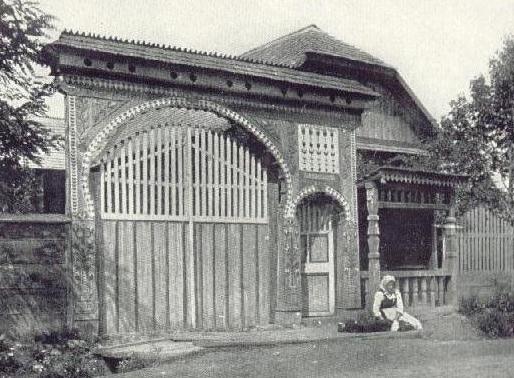
Edited and translated by Aranyi László
Woodcarving
The
Great Hungarian Plain is unbelievable rich in woodcarving
products. They show great skilfulness of the masters. In these
days there could be found many wonderful pieces of woodcarving,
though there are large areas in the Great Hungarian Plain without
trees, because it is clear that for carving small things there is
no need to have forests. At present times, it is obvious that
woodcarving is connected to the arias with forests, but hundreds
of years ago, most part of the Great Hungarian Plain was covered
by forests, so woodcarving was very common.
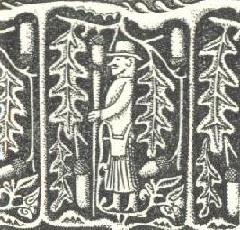
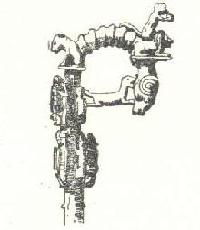
Flat
drawing of a carved stick - a shepherd Sunday's best stick
It
is not possible to describe all the types of woodcarving things,
but it can be said that one of the most ancient profession is the
shepherds' or pastors', as everybody knows them. They made lots
of different things: sticks, whip-handles, shepherd's crooks,
axe-handles, drinking-cups, lamb signs, pocket-knife handles,
corn-meal stirrers, plates, salt-cellars, ointment-cellars,
drinking-pots, dog-clogs, mirrors, razor-cases, flutes, bagpipe
heads, wood pipes, pipe-handles, frames, different pieces of
furniture, and so on.
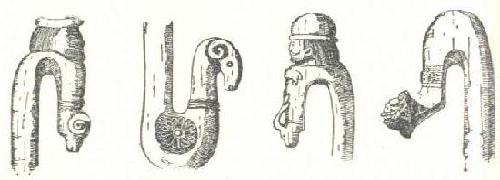
Shepherds'
hooks from Zala county
The materials, used by the pastors, were different. There are
some objects, which were made of the same type of wood. It was a
kind of custom or the pastors had the experiences about the types
of wood or both. Here are some examples: mirrors were made
usually of maple-wood, whip-handles of plum wood, and sticks of
dogwood or oak-wood. Gnarled sticks were formed by not only
carving, but also using the nature’s power itself as well. It
was common that the pastors chose a tree, made holes in it in
regular lines, then put a dogwood core into each holes. By the
end of the next year, the tree grew around the cores. This method
was possibly used for making handles for different tools, and was
known by the archaistic people too.
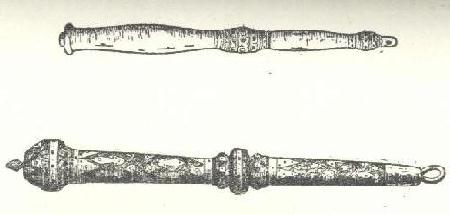
Carved
whip-handles
Every pastor has an own tool that is a kind of signification of
his profession, a kind of shield. He is the proudest of it. It
was common that the pastors carried their shields with them to
dedication festivals and markets. The pastor’s shield was the
shepherd’s crook, the herdsman’s was the stick,
horse-herd’s was the whip, and swineherd’s was the axe. There
were different types for different occasions: for everyday using
and their Sundays’ bests.

Carved
mirrors
The nicest whip-handles can be found near the river Danube. They
carved mainly geometric forms. On the crooks, there are
ram-heads, but there are horse heads, dog heads, man heads,
acorns or a group of different decorative elements. There is also
a very interesting type of carving; it is the earlier used
leather motifs carved into wood.
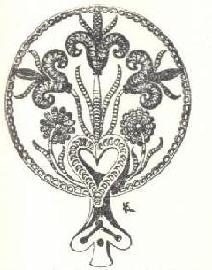
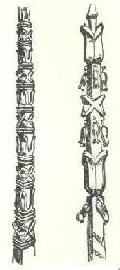
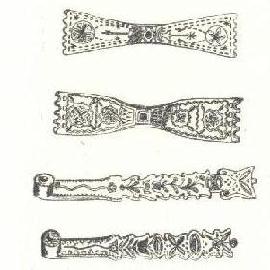
Bottom
of a drinking cup - distaffs' sticks - distaffs ssoles
The pastors’ life-style and their thinking of the world can be
found on their pocket mirrors motifs. Their carved lines are
sophisticated, but there can be found dark spots, as well. The
positions of their carved figures’ bodies are well worked our,
and are typical. They stressed on the clothes and dresses, the
motions, and the objects surrounding. Colouring the mirrors the
used vegetable paints and about two hundred years ago, it was
common to use sealing wax as well.
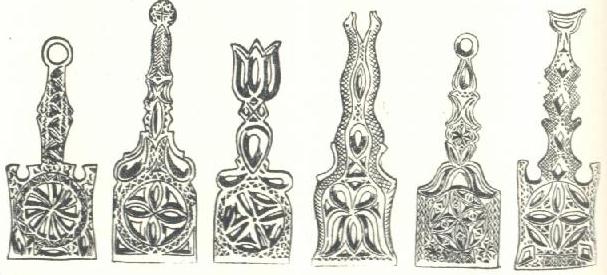
Hoe-cleaners
In the beginning, flat works were general, but from the 19th
century, mainly relief style was used. In the beginning, the long
objects’ (for example flutes and sticks) flat and sealed waxed
motifs followed each other in different tracks, but from the 19th
century, we can see that the motifs make complete compositions in
most cases rounded them by snakes. The motifs themselves are as
packed as possible that way is very typical in folk art.
The main themes of the pastors’ woodcarving are men and
animals, but can be found a great part of the flowers, too. The
flowers are generally in bunches, as it was common used in the
furriers’ and tailors’ works.
The pastors in their everyday work could be without their
drinking cups. It was carved from one piece of wood. They carried
them on their satchels’ straps. Drinking cups, with or
without handles, are known from the very ancient times. They
represent the oldest pieces of the archaeological objects in
Europe; because of this, they are very important. They similar to
those drinking cups, which are well known in Asia and they are
made of leather. They usually show different types of animals. They
often form the bird carrying the water of life.
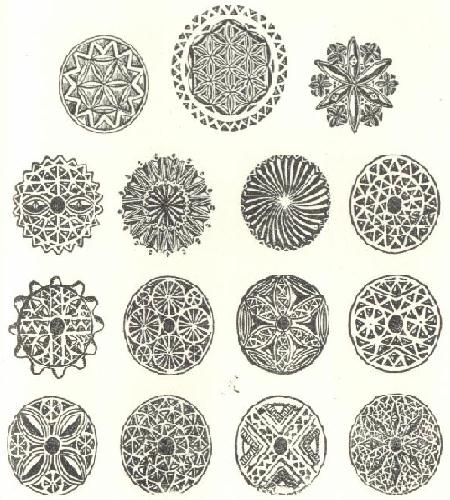 Rosettes
Rosettes
Among the objects and tools of the pastors, we have to talk about
those kinds of tools, which are known from the most ancient
times. Such kinds of tools are for example the spinner and the
viewer tools. From these, the distaff, the shuttle and the linen
stretcher. Their motifs are similar to the mangles’ and the
washing weighs’. From the point of view of decorating art these
objects are very important, because in general they were made by
young lads or young married men for the young girls or young
wives using traditional decorating arts. It was common to show
the wedding ceremonies parts, the dances, the dressing up, and so
on. Because the traditions were changed, the decorating styles
were changed too.
The oldest times mainly geometrical motifs were used, form
example different types of rosettes. We could recognize these
very old motifs on the furniture or in gothic buildings as well.
We can rank the hoe-cleaner among these objects. That is also
made for present.
This closed style of motifs is well known through over Europe and
Russia. It is interesting that these typical geometrical forms
are still used in the Great Hungarian Plain for decorating razor
boxes. This method can have very old traditions.
There are many different objects and tools in the Hungarian
carving art with geometrical and flourish motifs together. In the
beginning, these flowers were very similar to the rosettes. The
more realistic motifs of flowers spread out later. Then they were
used from the full scale of objects from the smallest one to the
doorposts.

Mangle
A typical piece of our carving art is the clothes-box or szuszék.
It was kept in the room of the peasant-house and was full of
clothes. It top and its sides were covered by decorative carving
works. These motifs were always geometric although there could
have been enough places to form something else. It is a
tradition. In addition, of course, different carving styles can
be found in different areas. It was common in Hungary to make
much more sophisticated carving works than the other nations
nearby us.
Among the agricultural tools, we can find a lot with carving. For
example, here are some: yokes, rakes, scythe whetstone boxes,
whip-handles, scythe handles and coaches. And, in the households,
there were plenty of carved objects, in addition to those that
were mentioned before, for examples decorated spinning wheels,
looms, salt cellars, spoon-boxes, matchboxes, candlesticks,
flower-stands and so on.
Of course, furniture was carved as well. Mainly oak trees were
use to make wardrobes, tables, chairs and so on. They are well
known in the wets part of Europe too. In the west part of
Hungary, we can recognize four typical themes of carving; these
are hunting, shepherding, farming and the life of soldiers.
Wooden
crosses and headboards
The first group of the so-called monumental works is the wooden
crosses, the wooden headboards and the cemeteries’ doorposts.
From the groups, mentioned before, the wooden headboards are the
most important because they show plenty of thousands of years old
traditions. They represent a kind of writing as well, carving in
wood. These kinds of headboards are still in used in the
Hungarian inhabited area of Romania.
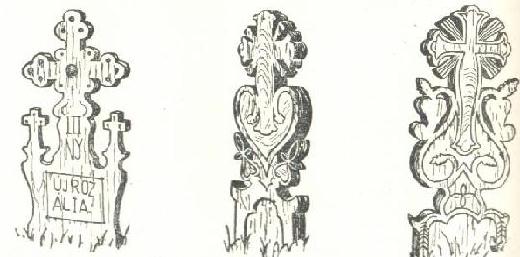
Wooden
crosses
Their shapes were usually like columns, becoming narrow on their
tops. The most ancient pieces of them were decorated with
geometrical motifs. They are very similar to the motifs that we
can find on the distaffs. Their typical elements were the eight
tipped, mace-like carving, rounded by equal sided triangles, and
a four-petal flower-like element and a kind of mix of them. Some
parts of Hungary it was common to use red and blue painted
headboards.
 Headboards
Headboards
The nicest wooden crosses are known from the north part of
Hungary. These are mainly in Baroque style. In the great
Hungarian Plain, the chiselled decorations were general. These
motifs were adjusted the natural waves of the wood, and show
mainly flowers and leaves. These stems sometimes came out from
flowerpots, and on the top of them, we can see looking-back
birds, the messengers of the other world. Similar type of carved
wood columns were used to show the frontiers. They usually show
human shapes.
Our tombs’ signs remind us human figures. It is possible that
in the ancient times they were human figures. They watched into
to infinitive space as the frontiers’ figures the owned lands.
Gates
They are called monumental works. The masterpieces can be found
in Transylvania (Erdély). Of course there were made a lot
through the country, but they are the best. It was common to
build hedgerows round the villages. In these hedgerows, you could
pass through these gates. There are very nice gates all over the
Great Hungarian Plain as well, in spite of the fact that there
are no big forests there. The nicest and the best worked-out
gates were made in Kalotaszeg and the Hungarian inhabited
Transylvania.
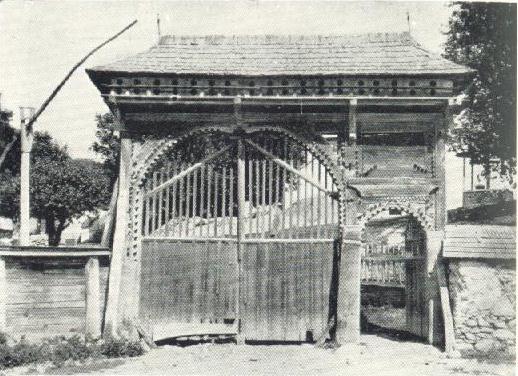
Székely
Gate
They were decorated with graved and painted rosette motifs, and
sometimes the maters carved flowers as well. There are doorposts
with festoon of flowers and branches of flowers in flowerpots,
but on these types of gates, we can see geometrical motifs as
well, but they are in the background or in the sides of the
gates. They have a special name: Székely-gate.
The size of the Székely-gate is monumental too. They were built
around three columns. On top of the columns, there can be seen a
kind of roof, and between the columns, there is a big and a small
gate (for humans and for coaches). Both of the tops of the gates
are usually arched, and covered with dovecotes. Over the small
gate, there are relieves-like and sometimes, painted carving. In
the eastern part of Erdély the common style is just carving, in
the western part of the country mainly painted too. The best
carved are known from Háromszék, and the best painted from
Udvarhelyszék.
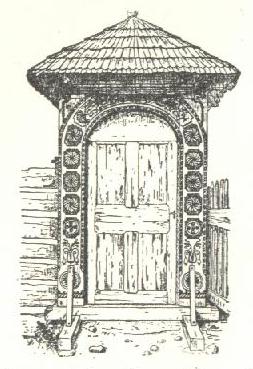 Székely
little gate
Székely
little gate
In the ancient times in Erdély, it was general to build a little
bit smaller gates leading to the yard. The gate could move on
giant doorpost that had a dovecote on top of it. This dovecote
was the sign that a noble family lived there. These kinds of
buildings and decorating styles sometimes were used in gates that
were built from stones.
The oldest Székely-gate we know about was made in Marosszék, in
1673, and it was stood up before the monastery named after St.
Francesco. This gate can be seen in Budapest now, in our National
Museum. Every decoration on this gate is geometrical.
The shields-like decorations, the notes in Latin ABC, the curses
upon enemies, the historical signs in decorations, show, that the
origin of the Székely-gates maybe come from the castles’
entrances. We could see such kinds of gates in Schedel’s World
Chronicle from 1498. The dovecotes could be originated from the
balconies that were built over the castles’ entrances.
The master of the Székely-gate was the carving-miller. The type
of this gate was familiar in Czech, in Germany, in Dutch, and in
Russia too. We also know carving gates from Turkey.
Houses,
Churches
In the medieval ages, the peasants lived in much simpler houses
than they did later. They generally were poor, as in almost every
part of Europe. The technique methods they applied were depended
on the materials they could use. Through the centuries, they
made perfect their building techniques. We can say that their
works are beautiful. Thatched huts and underground sank shacks
could be also very nice. To decorate anything is just possible
when there are materials that can be formed, there are lots of
them nearby, they are easy to form, and they are long lasting.
Such kind of material is the wood. As we really see, the
traditional folk style decorations were formed by carving axe, by
chisel, and much later by saw.
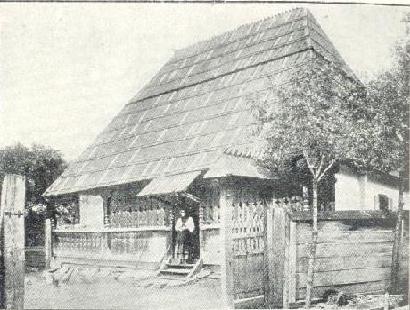
A
typical house
During the centuries when the Hungarian tribes got home to the
Carpathian basin we can see buildings made of wood, and churches
too. However, many of the villages were very poor, sometimes they
could not build church from reeds either. There were lots of
village with just one real house. Most part of the fortresses was
not built from wood or bricks, but from hedge or mud. For
example: Baranyavár, Kolozsvár and Sövényvár.
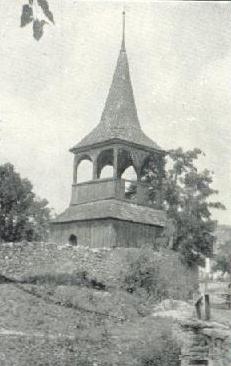 Bell
tower
Bell
tower
Many of the castles were not really built but were twisted as we
can see during the Turkey’s occupation of Hungary. These very
ancient methods of building were used for building churches, too.
And we can see these types of houses recently as well, the upper
region of river Tisza it is common for building peasantry houses.
There were of course many churches building from wood, for
example, the Protestant Church of Felsőbánya from 17th
century. We have hundreds and hundreds notes from similar
churches.
Wood churches are remained in those areas where the churches are
too poor to use stones or bricks for building in these days as
well, mainly outside of the present Hungarian border. It was
common to sell the wood church if they had enough money to build
a new one from stones or bricks. In these cases, the churches
were carried away for more kilometers. We had famous
church-carving villages. They made the churches in pieces, and
then the pieces were carried to the customer’s village, and
were put together there. Vámosatya in Bereg was such a kind of
village where famous wood churches were carved.
There are not any wood-churches remained. All of them were
destroyed the previous centuries by Tatars, Turkeys, and so on.
After the hard historical ages, the churches built from stones
and bricks. However there are very nice wood-towers or belfries
remained. They generally were built in Roman style with Gothic
archways, and were connected to the churches, mainly protestant
churches. In some places, it was common to build a baroque style
cover on top of the bell tower. A kind of mix of the different
architectural styles there can be found inside the churches. In
spite of this, they are very nice.
These wood churches and bell towers were planned by the popes of
the villages, and they directed the buildings themselves. They
specified the stiles of the churches, based on the technological
and cultural backgrounds. These methods were also used for the
inside furnishing and decorating. From the decorating styles, the
most common was the renaissance type of colorful ceilings that
usually made by wandering painters, not the craftsmen of the
villages. In their work we can see a kind of mixture of scholar,
provincial and rustic styles. Such kind of painted ceilings can
be found in the southwest, northeast of Hungary, and in Erdély.
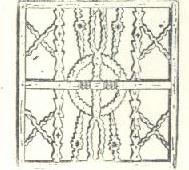 Window
grating
Window
grating
These painted ceilings were important for the folk art too,
because theirs motifs were a kind of base for other folk
craftsmen in their decorated works, for example, in woodcarving,
in embroiling, in painting, in pottery, etc. We could find some
written notes on the ceilings by the ancient Hungarian cuneiform
ABC. The using of this ABC was prohibited in the medieval era by
the Christian Church.
The Hungarian peasants’ houses were less decorated. However,
there were typical ways for making nicer them. The gables, the
verandas, the columns, the eaves, the frames of the doors and the
windows, the window gratings, the window boards, the crossbeams,
the buttresses, the walls covered by planks and the painted walls
had rich decoration. By our experiences, we can tell that these
kinds of decorations were used just for the noble persons houses
in the beginning.
Furniture
The customs of furnishing has changed. Recently it is common to
have many pieces of furniture, the houses and the flats are
packed. Centuries ago it was not so. The old pieces were made of
oak-wood or beach wood without using sew or sometimes plane. This
kind of furniture could not be painted. The only type of
decoration that could be used was carving. The first piece of
furniture that became common in the peasant house was the small
cupboard, or szuszék. The varied
decorations were made by using rules and compasses.
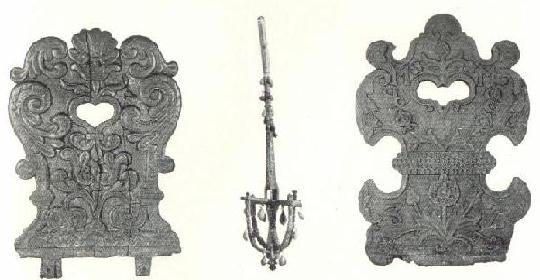
Chairs
The next generation of the furniture was the painted types. The
carpenters of the little towns worked to orders. They had to use
those common decoration motifs that were liked by the
inhabitants. The masters formed a kind of local style for peasant
houses, and these styles were mixed. The using of the different
colors made the peasants houses kindly, decorative and friendly,
but individual.
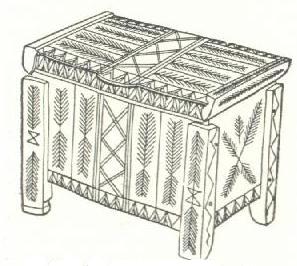 Szuszék
Szuszék
A special type of szuszék, the tulip szuszék
(with full of different colorful flowers) became famous and
fashionable all over Hungary about the 15th
century, mainly in the noble people’s houses. Later they could
be found in the peasant houses as well. The manufacturing
technologies were changed. By the 17th
century resin, cold or worm woodworking glue, and pitch were used
to fasten the planks together.
From the renaissance, the szuszék inherited
the using of arched columns. It was a very fashionable piece of
furniture. We can find similar types of szuszék
in Germany and Austria. If you want to see some new ones you have
to travel to Erdély where they
are still in use.
Recently we can see a new fashion wave to have carving things as
well.












 Rosettes
Rosettes

 Headboards
Headboards
 Székely
little gate
Székely
little gate
 Bell
tower
Bell
tower Window
grating
Window
grating
 Szuszék
Szuszék